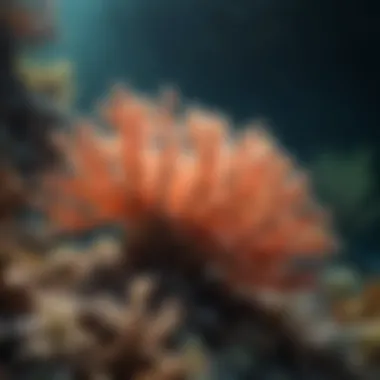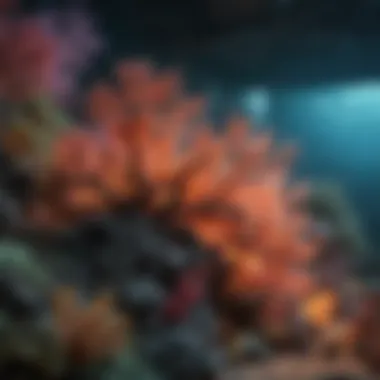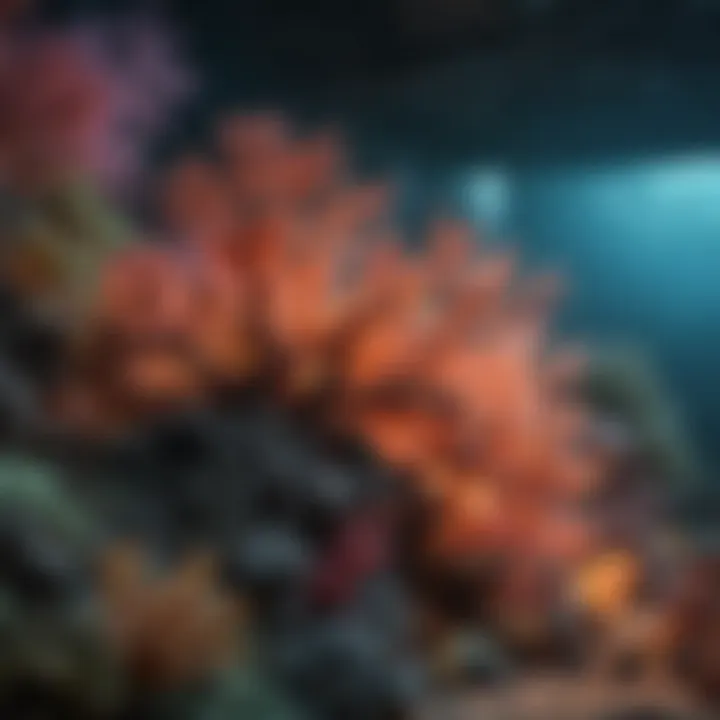Understanding Coral Light: Science and Environment


Intro
Corals are more than just colorful marine structures; they are integral to ocean ecosystems. Understanding how light interacts with coral is vital for their survival and health. Light availability affects coral growth, reproduction, and overall fitness. Various factors, such as water depth and clarity, determine how much light reaches these organisms. This article examines the complex relationship between corals and light, highlighting the scientific significance, physiological adaptations, and the role of human activity in coral reef ecosystems.
Background and Context
Overview of the Research Topic
The study of coral light is an emerging field within marine biology. Researchers focus on how light affects the physiology of corals. The main aspects include photosynthesis, which is critical for coral-algae symbiosis. Without adequate light, corals can become stressed and bleached.
Historical Significance
Historically, coral reefs have been viewed mainly for their aesthetic appeal. However, recent research shows they serve essential ecological functions. For instance, they provide habitats for diverse marine life. Understanding how light influences these ecosystems is crucial for conservation. As environmental threats increase, the need to safeguard coral reefs becomes even more pressing.
Key Findings and Discussion
Major Results of the Study
Recent studies indicate that different coral species exhibit varying responses to light conditions. Some thrive in shallow waters, while others prefer deeper environments. This adaptability is key to their resilience, but it's not unlimited. Overexposure to light can lead to bleaching, impacting the entire reef ecosystem.
Detailed Analysis of Findings
Research has shown that corals have developed specific mechanisms to cope with variable light conditions. For instance:
- Chromoproteins: Corals use these proteins to adjust the absorption of light wavelengths.
- Symbiotic Relationships: The relationship between corals and zooxanthellae is essential for nutrient exchange. Zooxanthellae perform photosynthesis, providing energy in return for shelter.
"Understanding the dynamics of light in coral ecosystems is crucial for predicting their future in a changing world."
The implications of these findings are profound. They underscore the need for effective conservation strategies. Furthermore, understanding light's role can help improve the management of coral reefs affected by human activities, such as pollution and climate change.
Prelude to Coral Light
Coral light is a crucial topic in understanding marine ecosystems. It refers to the specific types of light that penetrate water and influence coral biology and behavior. Light is not just a mere environmental factor; it serves as the foundation for photosynthesis, which is vital for coral survival. This section will explore the definition of coral light and its significance within marine ecosystems, establishing a basis for further discussions in the article.
Definition of Coral Light
Coral light is defined as the spectrum of sunlight that reaches coral reefs and supports their growth and survival. This light varies in intensity and quality depending on a number of factors, such as depth, water clarity, and the angle of sunlight. Light can be broken down into different wavelengths, each impacting corals differently. The primary wavelengths beneficial for coral photosynthesis are blue and green light.
Corals themselves can be considered both autotrophic and heterotrophic. This means they can produce their own food through photosynthesis while also obtaining nutrients from surrounding water. The light that reaches them is integral to the health of their entire ecosystem.
Importance in Marine Ecosystems
The role of coral light extends beyond merely enabling photosynthesis. It is also critical for the overall health of marine environments. Coral reefs are one of the most biodiverse ecosystems on the planet, housing an estimated 25% of all marine species despite covering only about 1% of the ocean floor. The availability and quality of light directly influence coral growth, reproduction, and resilience to stressors.
Key points regarding the importance of coral light include:
- Photosynthesis: The majority of corals host zooxanthellae, a type of algae that contains chlorophyll. These algae utilize sunlight to convert carbon dioxide and water into glucose and oxygen, which benefit both the algae and the host corals.
- Nutrient Cycling: Light influences the productivity of phytoplankton, which serves as a food source for many marine organisms and contributes to nutrient cycling within the ecosystem.
- Ecosystem Dynamics: Coral reefs provide habitats and shelter for countless marine species, contributing to global biodiversity. The health of these reefs is intrinsically linked to light availability.
"Coral reefs are the rainforests of the sea, and understanding their light requirements is essential for their conservation."
In summary, recognizing the definition and importance of coral light lays a foundation for addressing more complex interactions within coral ecosystems. It sets the stage for understanding how corals adapt to their light conditions and the consequences of environmental changes. As we delve deeper, these elements will become increasingly vital in appreciating the ecological balance that coral reefs represent in our oceans.
The Nature of Light


Understanding the nature of light is crucial when studying coral ecosystems. Light acts as a primary energy source, driving photosynthesis in many marine organisms, including corals. The interaction between light and these underwater environments influences the health and productivity of coral reefs.
Examining light's properties, wavelengths, and penetration can reveal how corals adapt to changing conditions and highlight the vulnerability of these ecosystems to environmental changes.
Properties of Light
Light is an electromagnetic radiation that travels in waves. It exhibits both particle and wave properties. These characteristics determine how light interacts with water and various materials found in coral ecosystems.
The speed of light in a vacuum is approximately 299,792 kilometers per second. However, when light enters water, it slows down, altering its path through refraction. This phenomenon is critical for understanding how light reaches coral reefs.
Other properties include:
- Intensity: The strength of light can influence photosynthesis efficiency.
- Spectrum: Light consists of multiple wavelengths, each with different energy levels and effects on coral structures.
- Polarization: This refers to the orientation of light waves, which may have effects on how organisms in the reef interpret their surroundings.
Wavelengths and Their Impact
Different wavelengths of light impact corals in various ways. The light spectrum ranges from ultraviolet to infrared, with visible light being most significant for photosynthesis. Light wavelengths can be categorized as follows:
- Ultraviolet (UV): Harmful to corals, excessive UV exposure can lead to tissue damage and bleaching.
- Visible light: Essential for photosynthesis, particularly blue and red wavelengths are most effective in stimulating coral growth.
- Infrared (IR): Generally not useful for photosynthesis but can affect thermal conditions in reefs.
Understanding these wavelengths helps elucidate how corals utilize light for energy conversion and how external factors, like pollution or sedimentation, can disrupt this critical process.
Light Penetration in Water
Light penetration in water is a key factor influencing coral growth and health. Water's turbidity, temperature, and biological activity affect how deeply light can penetrate the ocean surface. Generally, about 90% of solar energy is absorbed in the first 200 meters of ocean water.
Some notable aspects include:
- Clear water allows greater penetration, benefiting corals by providing more light for photosynthesis.
- Murky conditions reduce light availability, often leading to coral stress and decreased resilience.
- Depth plays a significant role; deeper corals are typically adapted to lower light conditions and might be less affected by shallow-water disturbances.
"Coral reefs are particularly reliant on effective light penetration to maintain their intricate ecosystems and support marine biodiversity."
Coral Biology: The Basics
Coral biology serves as a critical foundation for understanding the intricate relationships and dynamics present within coral ecosystems. Corals are not merely structures; they are complex living organisms that play significant roles in marine life. The study of coral biology unveils how corals function, grow, and interact with their environment. It is essential to appreciate the specifics of coral anatomy and the unique processes that facilitate their survival, particularly in relation to light and photosynthesis. Understanding these elements helps clarify why coral reefs are so vital to marine ecosystems and the impacts they face from environmental changes.
Coral Anatomy
Coral anatomy is fundamentally important for comprehending how these organisms thrive in various marine environments. Corals are composed of small polyps, which are tiny, often colorful animals that form colonies. These polyps are encased in a calcium carbonate skeleton, providing structural integrity to reefs.
Coral structures can vary greatly between different species. Some corals are small and encrusting, while others form large, branching assemblages. The arrangement of these polyps affects light capture and nutrient absorption. A key feature of coral anatomy is the gastrovascular cavity, where food is digested and waste is expelled. This cavity also plays a role in the distribution of nutrients throughout the colony. Understanding coral anatomy aids researchers in identifying how changes in their environment may impact their health and overall ecosystem dynamics.
Photosynthesis in Corals
Photosynthesis in corals is an essential topic concerning their biology and ecology. Corals have the ability to utilize sunlight through a symbiotic relationship with microscopic algae known as zooxanthellae. This process not only supports the coral’s energy needs but also contributes significantly to the ecological productivity of coral reefs.
Symbiotic Relationships
Symbiotic relationships between corals and zooxanthellae are a fundamental aspect of coral biology. This relationship allows corals to thrive in environments where light is available. The zooxanthellae live within the coral's tissues, using sunlight to produce sugars through photosynthesis. In return, the corals provide the algae with protection and access to sunlight. This arrangement is mutually beneficial.
A key characteristic of this relationship is its dependency on light availability. Corals can perform better in clear, shallow waters where light penetration is higher. This symbiosis is a popular topic in coral studies because it highlights the delicate balance that exists in marine ecosystems. However, it’s important to note that stressors like rising sea temperatures can disrupt this relationship, leading to phenomena such as coral bleaching.
Role of Zooxanthellae
The role of zooxanthellae in coral biology cannot be overstated. These algae are crucial for the productivity of coral reefs. They provide energy to corals via photosynthesis, enabling them to grow and contribute to reef building. Zooxanthellae also enhance the nutrient cycling within the reef ecosystem, supporting other marine life.
A significant advantage of zooxanthellae is their ability to help corals thrive in challenging environments by increasing their resiliency to nutrient fluctuations. However, these benefits can be overshadowed by stresses such as ocean acidification, where zooxanthellae may decline, affecting coral health. Thus, understanding the role of zooxanthellae is vital for grasping the broader implications of environmental changes on coral ecosystems.


"The life of the coral is integrally linked with its environment, demonstrating the importance of light and nutrients for overall health and stability. By studying coral anatomy and biology, we can better appreciate the challenges they face today."
In summary, thorough knowledge of coral anatomy and the photosynthetic processes that occur within them provides essential insights into the sustainability and fragility of coral ecosystems. This understanding informs conservation strategies that are vital for restoring and protecting coral reefs against the ongoing impacts of climate change.
Adaptation to Light Conditions
The adaptation of corals to varying light conditions is critical for their survival and growth. In marine ecosystems, light is a key factor influencing coral health and functioning. Understanding these adaptations helps highlight the intricate relationships between corals and their environment. Adaptation to light is not merely about survival; it plays a role in maximizing energy capture and reducing stress. This ensures that corals can thrive even in challenging circumstances.
Behavioral Adaptations
Corals exhibit various behavioral adaptations in response to light conditions. One notable behavior is the ability to extend their polyps during daylight hours when light intensity is highest. This provides corals with optimal opportunities for photosynthesis. Polyps contain zooxanthellae, the symbiotic algae that produce energy through photosynthesis. By adjusting their polyp extension in relation to sunlight exposure, corals optimize nutrient intake.
Moreover, some coral species can alter their morphology based on light availability. For example, corals in deeper waters tend to grow larger and more branched structures to capture the limited light. In contrast, those in shallow waters may develop flatter and denser arrangements to reduce damage from intense sunlight.
Physiological Responses
Physiological responses to light adaptation are equally essential. Corals adapt at the cellular level to optimize light use. One key adaptation is the modification of pigments within the zooxanthellae. Under high light conditions, corals may produce more protective pigments, reducing harmful effects from excess light. This capability is vital for preventing photo-damage to the coral tissues.
Additionally, corals can alter the composition of their symbiotic partners in response to changing light conditions. For instance, in environments with low light, corals may host different strains of zooxanthellae that have higher photosynthetic efficiency. This ensures that corals can maintain energy balance even under suboptimal conditions.
"Corals are exceptionally dynamic organisms that can respond to their environment in complex ways, demonstrating both behavioral and physiological adaptations that ensure their survival."
In summary, the ability of corals to adapt to light conditions involves a careful interplay of behavioral and physiological mechanisms. These adaptations are not merely responses to environmental challenges; they are essential for the ongoing health and viability of coral reefs in a changing climate.
Impact of Climate Change on Coral Light
The impact of climate change on coral light is a pivotal topic within marine biology. Coral reefs depend heavily on adequate light for photosynthesis, which is essential for their growth and survival. As climate change alters environmental conditions, it influences light availability, which can have cascading effects on coral ecosystems.
Rising Sea Temperatures
Rising sea temperatures are a direct result of climate change. These elevated temperatures can lead to coral bleaching, a process where stressed corals expel the symbiotic zooxanthellae algae that live within their tissues. This expulsion not only reduces the corals’ color but also diminishes their health and ability to photosynthesize. When temperatures exceed 30 degrees Celsius, corals struggle to maintain their symbiotic relationships. Consequently, this affects their overall survival rate, leading to more significant reef degradation.
Ocean Acidification
Ocean acidification occurs due to the increased levels of carbon dioxide in the atmosphere. When CO2 is absorbed by seawater, it lowers the pH, making the ocean more acidic. This change in acidity can hinder calcification processes in corals. Calcification is vital for coral growth, as it enables the creation of their calcium carbonate skeletons. If corals cannot effectively build their structures, their resilience to environmental stressors decreases. This can lead to a reduction in light penetration available to corals and the algae that depend on them.
Shifts in Light Availability
Shifts in light availability are influenced by various climate-related factors. Increased sediment runoff due to heavy rainfall and coastal development can cloud the water, drastically reducing the light that penetrates into coral habitats. Moreover, changes in water temperature and chemistry may impact the phytoplankton and algae populations that contribute to the overall light dynamics in marine ecosystems. As a result, the balance of light necessary for photosynthesis is disrupted, potentially leading to inadequate energy supply for corals.
The effects of climate change on coral light are complex and intertwined, requiring comprehensive efforts for understanding and mitigation.
Understanding these impacts enables researchers and conservationists to develop targeted strategies to protect coral ecosystems. Without realizing how climate patterns affect light, the future of coral reefs appears increasingly precarious. Thus, ongoing research and awareness initiatives are crucial.
Coral Reef Conservation Efforts
Coral reefs are among the most diverse ecosystems on the planet, providing essential habitat for numerous marine species. Conservation efforts for these ecosystems have become increasingly critical due to the threats posed by climate change, pollution, and overfishing. This section highlights the significance of coral reef conservation and examines effective strategies, including the establishment of protected areas and the importance of community involvement.
Importance of Coral Reefs
Coral reefs play a vital role in marine ecosystems. They support a rich biodiversity, functioning as nurseries for many fish species and serving as shelter for marine life. These ecosystems also provide food and resources for local communities and are crucial for tourism, particularly in coastal areas. Moreover, coral reefs help protect shorelines from erosion and buffer the impacts of waves, thereby shielding coastal habitats. Their loss would not only threaten marine biodiversity but also the economic and social stability of communities relying on them.
The health of coral reefs is directly tied to the overall health of oceans. Without robust coral systems, the biodiversity and resilience of the marine environment would decline, leading to cascading effects throughout the entire ecosystem. Thus, preserving coral reefs is not just an ecological imperative, but also a fundamental necessity for human well-being and economic sustainability.
Strategies for Conservation


Protected Areas
Protected areas are designated regions aimed at preserving the natural environment and biodiversity. In the context of coral reefs, these areas offer refuge from destructive human activities, such as overfishing and coastal development. They provide organisms within these ecosystems the needed space to thrive and recuperate from stressors.
One key characteristic of protected areas is their ability to facilitate enhanced fish populations. When fishing pressure is alleviated, species can reproduce and grow, which in turn supports larger populations in adjacent fished areas. These regions serve as a biology sanctuary that can repopulate damaged areas, proving to be a beneficial and effective conservation strategy.
However, the effectiveness of protected areas depends significantly on proper management and enforcement. A unique feature of these areas is that they must be regularly monitored, and ongoing scientific research is fundamental to adaptively manage them. There are challenges and potential downsides, such as conflicts between conservation objectives and local fishing needs, which must be navigated carefully.
Community Involvement
Community involvement in conservation efforts is essential for sustaining coral reefs. Local communities are often the primary stakeholders of these ecosystems and possess invaluable traditional knowledge about local marine systems. Their participation can enhance the effectiveness of conservation strategies by ensuring that local practices and customs are considered.
A key characteristic of community involvement is that it fosters stewardship. When people have a stake in the health of their coral reefs, they are more likely to engage in conservation practices. This approach has shown to be successful, as it incorporates local insights and reinforces sustainable practices aligned with community needs.
However, it is crucial to address the potential downsides of community involvement, such as inequity in benefits derived from these efforts. Balancing the needs of local communities with conservation goals is paramount. By integrating education and empowerment into conservation efforts, these challenges can be minimized.
"Successful coral reef conservation requires a multifaceted approach that includes scientific research, community engagement, and adaptive management strategies."
In summary, the conservation of coral reefs is vital for maintaining biodiversity and providing benefits to humans. Effective strategies, including the establishment of protected areas and active community involvement, hold promise for enhancing the resilience of these critical ecosystems.
Research and Future Directions
Understanding the current trajectory of coral research is crucial for many reasons. It offers insights into how corals respond to environmental stresses, particularly those induced by climate change. The outcomes of ongoing research shape strategies for conservation, rehabilitation, and management of coral ecosystems. Moreover, technological advancements play a significant role in enhancing our understanding of coral biology and ecology. This section will explore these emerging technologies and global collaborative efforts that aim to address the alarming decline of coral reefs.
Emerging Technologies in Coral Research
New technologies are reshaping coral research, enabling scientists to gather data more efficiently and accurately than ever before. Techniques such as high-resolution underwater imaging and remote sensing provide valuable information about coral health and habitat conditions.
Key Technologies include:
- Drones: Used for aerial surveys to monitor large reef areas without disturbing marine life. They provide detailed images and data on coral coverage and health.
- Genetic Sequencing: This helps in understanding the genetic diversity of coral species, which is vital for resilience to environmental changes. Studies using genetic tools enable researchers to identify species that are better adapted to changing light conditions and other stressors.
- Artificial Intelligence: Machine learning algorithms analyze extensive datasets, revealing trends and enabling predictive modeling. AI can process images from underwater cameras to monitor coral bleaching events and recommend timely interventions.
Research employing these technologies leads to better-informed decisions regarding coral management and conservation strategies.
Collaborative Global Initiatives
Across the globe, researchers are increasingly engaged in collaborative initiatives aimed at tackling coral reef degradation. These efforts underline the importance of sharing knowledge and resources in addressing a crisis that transcends borders. International organizations, universities, and environmental groups are forming networks focused on coral conservation.
Examples of Collaborative Efforts:
- The Coral Triangle Initiative: This partnership involves countries like Indonesia and the Philippines, focusing on preserving marine biodiversity and habitats. Commitment to data sharing supports regional conservation efforts.
- Global Coral Reef Monitoring Network: This project collects and shares data on coral conditions worldwide. It enhances understanding of coral reefs' health, facilitating coordinated responses.
- Research Partnerships: Collaboration between research institutions in different countries fosters knowledge exchange, enhancing local capacities to address specific challenges facing coral ecosystems.
These collective efforts exemplify how unified action can drive progress in coral research and conservation. By pooling expertise and resources, stakeholders intend to foster resilience in coral reefs, maximizing the impact of every research initiative.
In summary, ongoing research and collaborative initiatives are essential to develop innovative strategies that ensure the future of coral ecosystems in a changing world.
Ending
The conclusion of this article encapsulates the complex interplay between coral ecosystems and the light that sustains them. It emphasizes how coral light serves as a pivotal factor in the growth and restoration of coral reefs. Understanding this dimension is crucial as it directly links to the health and resilience of marine biodiversity. Without adequate light, corals struggle to perform photosynthesis effectively, impacting their ability to thrive and reproduce.
Summary of Key Points
- Role of Light: Light is fundamental for corals, enabling photosynthesis, which is essential for their energy needs.
- Adaptation Mechanisms: Corals exhibit remarkable adaptations to varying light conditions, ensuring their survival in different environments.
- Impact of Human Activity: Climate change and pollution significantly alter light availability, affecting coral health and marine ecosystems overall.
- Conservation Efforts: Active conservation strategies are necessary to mitigate the adverse effects on coral reefs and promote their recovery.
Call to Action for Conservation
Given the precarious state of coral reefs worldwide, there is an urgent need for collaborative efforts in conservation.
- Advocate for Policy Changes: Engage with local and national policies that protect marine resources. Urgent actions are needed to combat climate change and ocean degradation.
- Support Stable Practices: Support sustainable fishing and tourism practices that minimize harm to coral ecosystems.
- Awareness and Education: Educate yourself and others about the significance of coral reefs. This knowledge can empower communities to prioritize conservation initiatives.
In summary, conserving coral reefs is not just about preserving marine life; it is also about maintaining the health of our planet.







